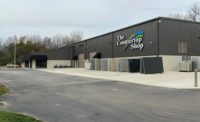"Reinforced masonry structures performed extraordinarily well in the recent earthquake, particularly when you consider that most of these buildings were not designed for a 5.8 earthquake," said David Sovinski, National Director of Technical Service for the IMI. "This real world experience supports recent testing done on the behavior of properly designed masonry buildings. When you apply research from the laboratory to proper training for craftworkers and contractors, you have an unbeatable combination; well designed buildings that are built according to that design. This improves our public safety and the value of our infrastructure."
The August 23 earthquake illustrates some common facts and fallacies about building design and construction. Structural engineers excel at designing structures to handle predictable forces on a building, those coming from the weight of the building itself, the loads from the occupants and environmental loads.
What is less simple are the occasional, harder to predict seismic loads from earthquakes. These operate primarily from side to side, with the force and energy coming in waves. As one wave moves the building to the side it will continue moving due to inertia briefly until it then begins to return to its original position. As the ground shifts, the building will continue to sway back and forth occasionally resulting in damage or failure.
A common solution for structural engineers is to stiffen or provide enough ductility for the building to resist anticipated drift back and forth from the seismic loads. A cost effective solution is reinforced masonry -- combining the strengths of masonry and steel to provide a building system that can withstand seismic and other building loads.
Q. Why don't we just use West Coast building codes on the East Coast?
A. This is a common fallacy. Actually national model codes use Seismic Design Categories (SDC) in determining requirements for buildings. The SDC takes into account several factors, including earthquake potential, soil types and the type of building -- for example, hospitals may have additional requirements than perhaps a corner carry-out.
Q. So all codes, East Coast and West Coast are essentially the same?
A. No, local jurisdictions do have the ability to modify the national or model code. So, for example, the California state building code has stricter seismic requirements for their structures than say Florida, where wind loads are a higher concern.
Q. So the building codes on the West Coast are identical to the East Coast?
A. The national model codes do not differentiate by coast, but states frequently modify the national model codes when adopting them in their jurisdictions, so the California state building code for example, does have what is considered stricter seismic requirements for their structures.
Q. In the U.S., are there areas other than the West Coast where the SDC is high?
A. Certainly the West Coast is almost all in the higher seismic design categories (SDC), but surprising to some, there are areas in the Mid-west and East Coast that have SDC ratings as high as those on the West Coast. The New Madrid fault (located along the boundaries of southern Illinois, western Kentucky, western Tennessee, eastern Missouri and eastern Arkansas) is one such location, as is the area around Charleston, SC.
Q. How do masonry structures perform in an earthquake?
A. Extremely well. Testing in a laboratory environment and experience in actual earthquakes show that reinforced masonry is an excellent solution for seismic design. Recent research, including testing of full-scale buildings, showed that masonry veneer when connected to the back-up system per current code requirements performs very well under even extreme seismic loading.
"Since the building stock on the East Coast was not necessarily built with earthquakes in mind, it is gratifying to see how well the masonry buildings performed," said Sovinski. "The more massive buildings naturally perform better, and the newer, reinforced buildings withstood the earthquake as well. Combining good design with good craftsmanship is critical. At IMI we have a special program of Grout Certification for craftworkers, and a Structural Masonry Certificate Program for contractors, which enables members of the International Union of Bricklayers and Allied Craftworkers and their contractors to build to the highest standards of design.


